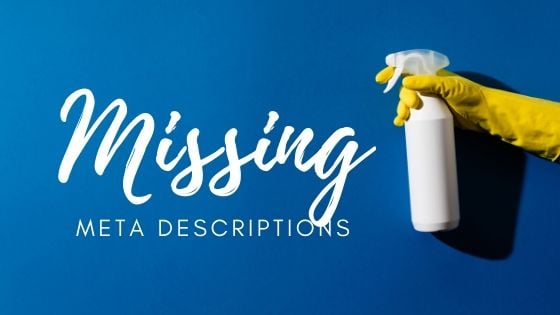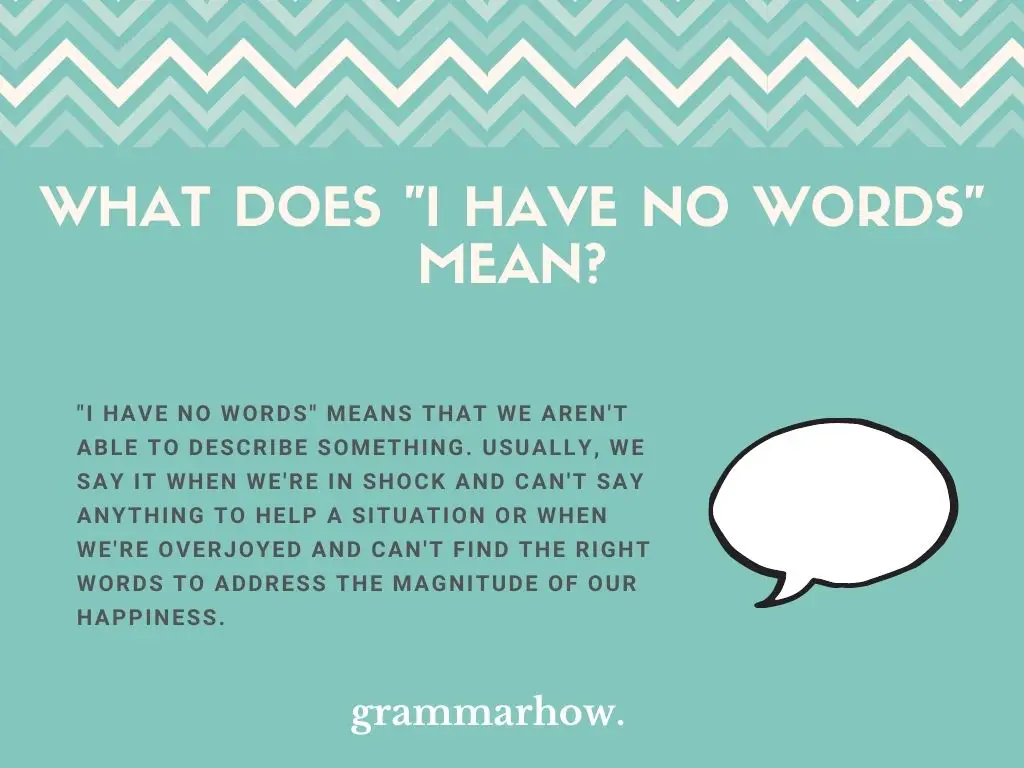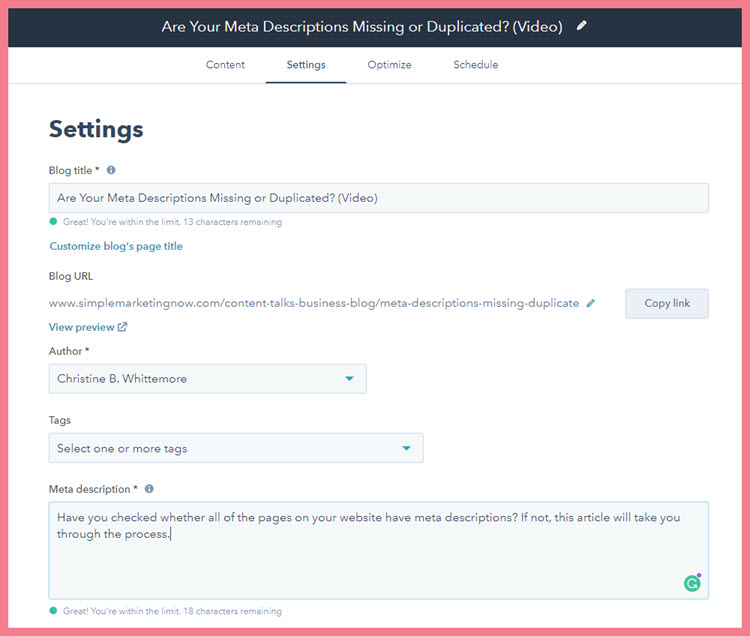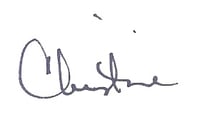Русский
English
Český
Deutsch
Español
عربى
Български
বাংলা
Dansk
Ελληνικά
Suomi
Français
עִברִית
हिंदी
Hrvatski
Magyar
Bahasa indonesia
Italiano
日本語
한국어
മലയാളം
मराठी
Bahasa malay
Nederlands
Norsk
Polski
Português
Română
Slovenský
Slovenščina
Српски
Svenska
தமிழ்
తెలుగు
ไทย
Tagalog
Turkce
Українська
اردو
Tiếng việt
中文
“I have no words” is a relatively common phrase you’ll come across in English. It’s helpful to know what it means, and this article will explore the definition for you and talk you through the best ways to use it for yourself.
What Does “I Have No Words” Mean?
“I have no words” means that we aren’t able to describe something. Usually, we say it when we’re in shock and can’t say anything to help a situation or when we’re overjoyed and can’t find the right words to address the magnitude of our happiness.
The definition of “have no words,” according to The Collins Dictionary, is “to be incapable of describing.”
It has two common meanings. We use it negatively to say that we don’t have any words to address our shock or horror about a situation. We could also use it in a positive way to say that we’re far too happy to come up with suitable words about something.
Examples Of How To Use “No Words” In A Sentence
There are a few ways that “no words” and all variations of it might appear. We thought it would help you to see them in action; that way, you can start looking into using them for yourself.
“No words” and all variations are best when you can’t find the right words to describe how you feel.
- I have no words to console you, and I’m so sorry for your loss.
- I can’t believe you did that to me! I have no words!
- No words can define just how betrayed I feel by you all.
- I have no words that will help me explain what I’m looking for.
- There are no words in this world that’ll make this any easier for you.
- I’m so sorry; I have no words.
- I can’t believe you got me this! I have no words!
- Are you getting engaged again? Wow, I have no words.
- I honestly have no words to help you through this.
- He has no words for me. I guess I’m on my own.
The most common meaning of “no words” is in a negative sense, where the speaker doesn’t have any words to give us to console us or make us feel better.
We usually say “I have no words” when we can’t think of something to help describe the situation we’re in. It means we’re not able to lighten the mood, and often we can’t believe the things that we’re hearing.
Is It A Compliment When Someone Has “No Words”?
It’s very rare for “no words” to be a compliment, but that doesn’t mean it’s impossible.
“No words” is a compliment when someone can’t find the words to describe their excitement about something that you’ve done for them, or if they can’t find useful words to describe something good about you. Otherwise, it is not a compliment and shouldn’t be treated as such.
Compliment
Let’s go through the only time where “no words” is a compliment first.
- I got you this present that I know you wanted!
- Wow! I have no words! Thank you so much!
In this sense, someone has treated us with a gift, and we don’t have the right words to accept it. “No words” is a compliment and positive comment here.
- How do I look in this dress?
- I have no words!
Here, “I have no words” is used to say that we can’t find the right words to describe the person. In this sense, it’s positive because we think they look so good that no words will do them justice.
Not A Compliment
Let’s flip this around and see how “no words” isn’t a compliment.
- I’m getting married again!
- I have no words.
When delivered negatively, “no words” here is used for shock or disbelief. In this example, we simply don’t believe that the person speaking is getting married “again.”
- How do I look in this dress?
- I have no words.
This is identical to the positive one from above; however, the delivery is important here. In this case, the “no words” are used to say that we simply can’t be nice about how they look, so we don’t want to say anything at all.
- I’m really struggling after my dad passed.
- I have no words to help.
This one isn’t an insult like the others, but it’s also not a compliment, so it fits here. We’re simply saying we can’t find the right words to help out someone who needs it, so we don’t say anything.
Should I Use “I Don’t Have Words” Or “I Have No Words”?
“I don’t have words” is the same as “I have no words.” They are interchangeable phrases, and most native speakers don’t mind which one is used. “I have no words” is more common in informal and casual conversations.
Generally, “I have no words” is spoken more often by native speakers, while it’s more common to see “I don’t have words” in more formal pieces of writing.
“I don’t have words” follows the more formal language and grammar rules, using an auxiliary verb “to do” along with the main verb “to have” to create the sentence structure. It’s not as common in spoken English, but it’s considered the correct version of the two.
“I have no words” is officially recognized as a correct phrase, but it uses only one verb, “to have.” It’s less formal for this reason, and you’ll have more luck using it in casual conversations with friends or family.
No Words – Synonyms
A few synonyms and alternatives might interest you that have a similar meaning to “no words.”
- Speechless
- Lost for words
- At a loss
- Tongue-tied
- Dumbstruck
- Mute
- Inarticulate
- Voiceless
- Dumbfounded
- Shell-shocked
- Astounded
The meanings of all of the words above are similar to “no words.” We can use them in much the same situations, where we simply can’t come up with good descriptive words to help a situation.
If you find yourself struggling to think of a good thing to say in a conversation, any of the synonyms above are ideal for you.
Martin holds a Master’s degree in Finance and International Business. He has six years of experience in professional communication with clients, executives, and colleagues. Furthermore, he has teaching experience from Aarhus University. Martin has been featured as an expert in communication and teaching on Forbes and Shopify. Read more about Martin here.
На основании Вашего запроса эти примеры могут содержать грубую лексику.
На основании Вашего запроса эти примеры могут содержать разговорную лексику.
The conference was organized at a good level, I have no words to describe my feelings of gratitude to you and your company.
Конференция была организована на хорошем уровне, у меня нет слов описать мои чувства благодарности Вам и Вашей компании.
There are no words to describe what we have experienced here this weekend.
There are no words to describe what happened.
There are no words to describe last night.
There are no words to describe how helpless I feel.
There are no words to describe him.
There are no words to describe what he felt.
I have no words to describe this man.
He has no words to describe his anger.
There are no words to describe everything it contains…
He had no words to describe his happiness.
There exist no words to describe Him fully.
I have no words to describe Taormina.
I had no words to describe what I was seeing or experiencing.
There’s no words to describe the feeling I had that day.
There are no words to describe how wonderful this book is.
There are no words to describe the pain we are feeling, he said.
There are no words to describe my gratitude to all of you for this remarkable gift.
are no words to describe all of this!
There are no words to describe this place.
Результатов: 222. Точных совпадений: 222. Затраченное время: 93 мс
Documents
Корпоративные решения
Спряжение
Синонимы
Корректор
Справка и о нас
Индекс слова: 1-300, 301-600, 601-900
Индекс выражения: 1-400, 401-800, 801-1200
Индекс фразы: 1-400, 401-800, 801-1200
This is a
8 minute read.

If you’ve not checked, this article will take you through the process, starting with what a meta description is, how to find one on your website, and how to make edits.
This article is part of the website housecleaning series.
>> See How To Fix Broken Links on Your Website (Video)
The Basics of Meta Descriptions
What’s a Meta Description?
Meta descriptions are those short snippets of text that show up in online search results under your website title tag. A compelling meta description can encourage someone to click on your listing and drive searchers to your website.
According to SEO Moz,
«The meta description is an HTML attribute that provides a brief summary of a web page. Search engines such as Google often display the meta description in search results, which can influence click-through rates.»
Why Is a Meta Description Important?
Visibility in Search Results
Although technically not a part of the search algorithm, meta descriptions play a significant role in your website on-page SEO which helps you get found online. In other words, through your meta descriptions, you have the opportunity to creatively specify your very own crafted summary of what each webpage represents for your business.
Each page of your site stands alone. With distinct content and page descriptions, you can amplify your content and opportunity to get found in search and drive a prospective customer to your site.
Visibility on Social Networks
From a social network posting perspective, when you publish a web page or blog article to Facebook or LinkedIn, for example, the network pulls your meta description.
The same goes for social bookmarking sites. The description provides more detail about the link so you have more context when you revisit your bookmarks.
What If Your Meta Description is Missing?
Although search engines like Google don’t always opt to showcase your carefully crafted description, if you have none, they will generally pick whatever shows up on your page — whether relevant or appropriate or not — to fill the gap.
For that reason, be on the lookout for missing descriptions. It’s to your advantage to specify what it is that you want detailed so you can ensure your company is putting its best foot forward.
By the way, your description isn’t set in stone. You can modify it as your business evolves. Think of it as the digital alternative to what you might include on your store window or a bill board to catch the attention of passers-by.
It’s a digital promotion for your business.
>> How to create the right meta description
Seek Inspiration From Other Meta Descriptions!
As geeky as this topic is, it’s also basic marketing. You can have fun with it starting with the research process.
You can learn a great deal by seeing what other people have written about their businesses and how those descriptions support (or don’t) their goals.
>> See SEO Tips: Having Fun with Title Tags and Meta Descriptions
I recommend researching companies you like, businesses in your geographic area, as well as competitors.
See how they describe their business and engage readers.
And don’t forget to check out multiple pages.
5 Best Practices for Meta Descriptions
1. No Missing Meta Descriptions
If a page on your site is important, make sure it has a respectable meta description.
2. No Duplicate Meta Descriptions
Each page on your site stands alone and requires a descriptor that’s unique to that page.
3. Be Succinct
You have 150 to 155 characters for adequately describing what’s going on you on your web page. Make each character count. Place your most important information first.
4. Use the Right Words
Include search terms or topics that are relevant to that page and to your visitors. Research your terms to determine which are best for your business.
Have fun. It’s okay to show humor or emotion. Remember that you’re appealing to people like you.
5. Engage With Verbs
Be active in how you construct your meta description. Stay away from passivity. Rather, invite action with call-to-action verbs.
>> For inspired writing advice, be sure to explore Ann Handley’s Total Anarchy and subscribe to her newsletter.
Wondering How To Find Your Website Meta Descriptions?
Here are three ways for finding the meta descriptions on your website.
1. View Page Source
Go to any page on your website.
Right click and a popup will appear.
Select ‘view page source.’ That brings up the HTML behind your beautiful web page.
Next, do [control] F to bring up a search window.
Type in ‘description’ and you’ll see that term highlighted and your meta description visible.
2. SEO Plugins
You can use an SEO browser plugin such as SEO Quake.
Click on the plugin icon. In addition to showing you Alexa ranking data and pages indexed, it will offer you a link to ‘page details.’
That link nicely pulls out the page details in a user-friendly format.
3. Do a Site Audit Using Paid Tools
You can also use paid SEO tools such as Ahrefs.
There, do a site audit and you’ll discover missing meta descriptions, duplicate meta descriptions, ones that are too long as well as too short.
Next is taking care of missing or duplicated descriptions. For that, you’ll need to go into your website content management system (CMS).
Here are three possible CMS scenarios.
1. Using HubSpot’s CMS
My website is built on the HubSpot content management system.
To add meta descriptions, I go to the page’s settings tab (see image above) and type in my content.
This tool kindly tells me whether I’ve used up all 150 characters or have characters remaining. (The Optimize tabs checks on other SEO elements such as image <alt> tags, content length, etc.)
2. Using WordPress and the Yoast Plugin
In WordPress, you’ll find the Yoast SEO plugin a tremendous asset.
Use it to edit your meta description snippet. It tells you (with green) when you’ve have just the right number of characters (not too few, not too many).
3. Using Magento + Microsoft Word
Some content management systems aren’t as friendly or robust with their guidance.
One example is Magento where you can type in a description but you have no word count to determine whether you’re optimized.
Another is BigCommerce.
A work-around is to use a blank Word document to type in your content. Confirm the character count and then go paste it into your content management system.
Your Meta Descriptions Are Similar to Google Ads Copy!
Unlike Google Ads, you don’t have to pay for your meta descriptions. Make the most of them to tell your story!
Make sure none are missing.
Make sure each is complete and unique.
This 155 character snippet is your chance to promote your business, engage people and get them to click on your content. Include important keyword terms and a call to action.
Watch the Video on Checking for Missing or Duplicate Meta Descriptions
The video is 8:34-minutes long and includes a cameo of my cat, Cinders.
Your Turn to Check Out Your Meta Descriptions!
Let me know how it goes, what you discovered from this process, and whether to add any steps or watch-outs based on your experience.
Thanks for reading and watching!
Note: We originally published this article on June 10, 2020, and have updated it.
Topics:
customer experience,
SEO & Search Tips
Leave a Comment:
Use of the phrase «have no words» to indicate (as Centaurus says) «not know what to say» goes back much farther than I originally thought it did. The earliest relevant Google Books match for the phrase has the more particular sense «words are inadequate» or «words fail us.» From Frederick Faber, The Creator and the Creature, Or, the Wonders of Divine Love (1857):
We have no words to tell the power of God. We have no ideas by the help of which we can so much as approach to an honourable conception of it.
…
If earth be such a heaven to believing souls, what sort of heaven must the real heaven be? What is that incomparable Beauty which the blessed are gazing on this very hour? We have no words to tell, no thoughts to think it. What is it that that beauty is doing to their capacious, serene, and glory-strengthened souls? We have no words to tell, no thoughts to think it. What is that divine torrent of love which bursts forth from it, and threatens to submerge and overwhelm their separate created lives? We have no words to tell, no thoughts to think it.
The notion that the failing is not in the incapacity of words themselves, but in one’s inability to summon or speak the appropriate ones, first appears in the Google Books search results in Frederick Harper, Wayside Words (1879):
I offered to join in prayer : «Alas,» she said, «I cannot pray, I never have prayed, I have no words, and alas, alas, I have no heart.» I answered, » The Lord Jesus Christ who died for sinners, and is now at the right hand of God, ever liveth to make intercession for His poor ignorant people.»
A somewhat older phrase with essentially the same sense is «at a loss for words.» The first instance of that phrase in a Google Books search is from a letter of November 13, 1722, from Port-Royal, Jamaica, describing a hurricane there, reprinted in The Historical Register: Containing an Impartial Relation of All Transactions, Foreign and Domestick. For the Year 1723 (1723):
And here I confess myself at a Loss for Words to give a just Description of the Horror of that Scene that we the Inhabitants saw before our Eyes, when the Terrour of the Sea that broke in upon us from all Quarters, with an impetuous Force, conspir’d with the Violence of the Wind to cut off all Hopes of Safety from us; and we had no other Choice before us, but that dismal one of perishing in the Waters if we fled out of our Houses, or of being bury’d under their Ruins if we continu’d in them.
Although «at a loss for words» comes up only in the context of «don’t know what to say,» whereas «have no words» can arise in various other circumstances as well as in that one, an Ngram chart tracking the two phrases over the period 1700 to 2000 indicates that «at a loss for words» (red line) has become considerably more common than «have no words» (blue line) in published writing since about 1950:
description — перевод на русский
/dɪsˈkrɪpʃən/

THIS TIME, I HAVE A VERY GOOD DESCRIPTION OF HIM.
На этот раз у меня есть его хорошее описание.
The description fits.
Описание совпадает.
— Give us a description of her.
— Дайте нам ее описание.
That’s a very good description.
Это очень хорошее описание.
Says he’s got a complete description.
Говорит, у него есть описание. Выкладывай, Эдвин.
Показать ещё примеры для «описание»…
Can you give me a description of this person you saw?
Ты можешь описать того человека, которого видела?
Perhaps you could let us have a description of them.
Вы сможете описать их?
Consciousness is free because there is no mathematical description of the subject… only objects can be described mathematically… and only to the extent that they are possibilities.
Сознание свободно, потому что невозможно математически описать субъект. Только объекты могут быть описаны математически, и то только как вероятности.
— Did you not get a description?
— Описать сможешь?
I can’t give much of a description, I’m afraid, but he’s sitting on one of the bollards and he’s tapping his thighs, you know, like he’s drumming along to a song.
Я боюсь, не смогу описать его подробней. Он сел на одну из тумб, он притопывал ногой, как бы отбивая ритм песни.
Показать ещё примеры для «описать»…
Listen, to be honest, home deliveries aren’t really part of my job description.
Слушай, если честно, доставка на дом не входит в мои обязанности.
— lt’s not in my job description….
— Это не входит в мои обязанности….
Is eavesdropping part of your job description, Mr. Stroud?
— Подслушивание тоже входит в ваши обязанности, мистер Страуд?
Because pronouncing people dead is not part of our job description.
У становление факта смерти не входит в наши обязанности.
This is so far out of my job description, it’s not even funny.
Это совсем не входит в мои обязанности и это даже не весело
Показать ещё примеры для «обязанности»…
I saw no one of Ugarte’s description.
Я не заметил никого, похожего на Угарте!
I don’t recall meeting anyone who matches that description.
Не могу припомнить никого похожего.
Hey, you know somebody who fits that description?
Эй, вы знаете кого-то похожего на него?
I mean, I haven’t seen anyone on this train by that description.
Не припоминаю никого похожего.
Dad’s fingerprints aren’t in the system and there’s no missing person report on file that matches his description.
Отпечатков отца нет в системе Он не числиться в списках пропавших и нет даже человека, похожего на него
Показать ещё примеры для «похожего»…
DID YOU GET A DESCRIPTION?
Их приметы?
I’ll give you his description.
Я дам вам его приметы
No one fits your description.
Никого похожего на Ваши приметы.
— Any description of the assailant?
— Какие-либо приметы нападавшего?
Just look here, his description is being broadcast all day on TV!
Вот пожалуйста, по телевизору его приметы целый день передают!
Показать ещё примеры для «приметы»…
Well, it’s part of my job description, but if you’re one of those shy guys,… you try that stall there.
Вообще то это часть моей работы, но если ты стеснительный мальчик,… можешь попробывать, закрыться в той комнатке.
I really agonized over the job description
Я и правда приукрасил предложение работы.
I should warn you that part of my job description is to remove vital organs.
Должен предупредить, что удаление жизненно важный органов — это часть моей работы.
I’ll call Robbie and make it okay. Half your job description is being disarmingly seductive.
Я позвоню Робби и сглажу, но часть твоей работы — это сидеть и мило улыбаться.
That’s part of the job description.
Это часть работы.
Показать ещё примеры для «работы»…
But… it’s just that it matches the description of —
Но, это лицо совпадает с описанием…
You’ll see it matches the description of your sister.
Интересно, что всё совпадает с описанием вашей сестры.
Matches the description of Captain Jennings.
Совпадает с описанием капитана Дженнингса.
And that also matches the description of the car used in the drive-by last night.
Он же совпадает с описанием автомобиля, из которого вчера стреляли у бара.
Matches the description of the student that was seen leaving Cutler’s office in tears.
Совпадает с описанием студентки, выбежавшей из кабинета Катлера в слезах.
Показать ещё примеры для «совпадает с описанием»…
Fits the description.
Соответствует описанию.
That matches the description of my father.
Это соответствует описанию моего отца.
Because whilst our Mr Tanner does fit the description given by Ms…
Потому, что хотя мистер Таннер соответствует описанию, данному мисс…
That fits the description of the woman from the motel.
Полностью соответствует описанию женщины из мотеля.
We got report of a gunman that matches the description of your homicide suspect, Lorelei Martins.
Мы получили сообщение о вооруженной девушке, которая соответствует описанию вашей подозреваемой, Лорелей Мартинс
Показать ещё примеры для «соответствует описанию»…
The woman he’s following meets Lisa’s description.
Женщина, которую он преследует, по описанию похожа на Лису.
Matches Levinson’s description of the gopher who paid him.
По описанию похожа на шестерку, которая заплатила Левинсону.
Woman, meets Rayna’s description, driving like a maniac.
женщина. по описанию похожа на Рейну. ведет как маньяк.
Very drunk guy has admitted knocking a man over near Cardiff. Fit’s Eugene’s description.
Очень пьяный парень признал, что недалеко от Кардиффа сбил человека, по описанию похожего на Юджина.
I checked with all local hospitals, clinics, urgent cares-— none of them have a GSW victim that matches Sean Quinn’s physical description.
Я проверил все близлежащие больницы, клиники, медпункты и не обнаружил никого с огнестрельными ранениями по описанию похожего на Шона Куинна.
Показать ещё примеры для «описанию похожа»…
If you do have any problems or you see anyone matching the description that we gave you, please, for your own sake, give us a call.
Если у вас возникнут проблемы, или вы увидите кого-то, подходящего под описание, пожалуйста, ради вашей безопасности, позвоните нам. Хорошо?
They couldn’t find anyone of that description, so they got a makeup artist to black-up a group of white men, but not including their hands. GROANING
Они не смогли найти никого, подходящего под описание, поэтому они наняли визажиста, чтобы полностью покрыть темной краской группу белых людей, оставив лишь ладони.
I see somebody who fits the description of the kidnapper.
Я вижу кого-то, подходящего под описание похитителя.
So, have security go through the tapes and see if they can find anyone that matches the description Maggie gave us.
Так, попросите охранников просмотреть записи с видеонаблюдения и поискать хоть кого-нибудь, подходящего под описание, которое дала нам Мэгги.
Someone answering his description has been seen in this neighbourhood.
Подходящего под описание человека видели неподалёку.
Показать ещё примеры для «подходящего под описание»…
Отправить комментарий
Смотрите также
- описание
- описать
- обязанности
- похожего
- приметы
- работы
- совпадает с описанием
- соответствует описанию
- описанию похожа
- подходящего под описание
описание, изображение, вид, род, сорт, вычерчивание
существительное ↓
- описание; изображение
faithful [racy] description — правдивое [колоритное] описание
description of a storm [of smb.’s appearance] — описание бури [чьей-л. внешности]
description of a horse — спецификация на лошадь (конный спорт)
beyond description — не поддающийся описанию, неописуемый
to give a (detailed) description of smth. — дать (подробное) описание чего-л.
to answer (to) the description — подходить под описание; иметь указанные приметы
it baffles /beggars, defies/ description — это не поддаётся описанию
- разг. вид, род
books of every description — всевозможные книги
people of all descriptions — люди всякого звания
a lecture of the poorest description — никуда негодная лекция
- вычерчивание
description of a circle — описывание окружности
description of an arch — вычерчивание дуги
- лог., лингв. дескрипция
definite description — определённая дескрипция
Мои примеры
Словосочетания
a writer with a gift of description — писатель, обладающий талантом к описанию 
a particular description of the room — подробное описание данного помещения 
to be a master of description — мастерски описывать 
accurate / correct / exact description — точное описание 
clear description — чёткое описание 
detailed / thorough description — подробное описание 
glowing description — яркое описание 
lively, picturesque, vivid description — живое описание 
matter-of-fact, objective description — объективное описание 
superficial description — поверхностное описание 
job description — должностная инструкция 
to give / provide a description — описывать 
Примеры с переводом
The description checks with the photograph. 
Описание соответствует фотографии.
His description does not square with reality 
Его описание не соответствует действительности.
His description quadrates with yours. 
Его описание совпадает с вашим.
The police have put out a description of the thieves. 
Полиция распространила описание воров.
This description must be sent in a letter post-paid. 
Это описание должно быть послано в письме с оплаченными почтовыми расходами.
The booklet gives a brief description of each place. 
В буклете даётся краткое описание каждого места.
The writer began with a description of the area. 
Автор начал с описания местности.
ещё 23 примера свернуть
Примеры, ожидающие перевода
I checked my job description. 
He matches the description of the attacker. 
The description was deliberately non-specific. 
Для того чтобы добавить вариант перевода, кликните по иконке ☰, напротив примера.
Возможные однокоренные слова
Формы слова
noun
ед. ч.(singular): description
мн. ч.(plural): descriptions
English[edit]
Etymology[edit]
From Old French description, from Latin dēscrīptiō, noun of action of dēscrībō (“I describe”).
Pronunciation[edit]
- (UK) IPA(key): /dɪˈskɹɪpʃən/
Noun[edit]
description (countable and uncountable, plural descriptions)
- A sketch or account of anything in words; a portraiture or representation in language; an enumeration of the essential qualities of a thing or species.
-
give a verbal description of the events
-
a realistic description
-
- The act of describing; a delineation by marks or signs.
- A set of characteristics by which someone or something can be recognized.
-
The zoo had no lions, tigers, or cats of any description.
-
- (taxonomy) A scientific documentation of a taxon for the purpose of introducing it to science.
-
The type description of the fungus was written by a botanist.
-
- (linguistics) The act or practice of recording and describing actual language usage in a given speech community, as opposed to prescription, i.e. laying down norms of language usage.
- (linguistics) A descriptive linguistic survey.
Synonyms[edit]
- (characteristics): sort, kind, type, variety
Derived terms[edit]
- audio description
- beggar description
- charge description master
- description logic
- description word
- descriptional
- descriptionally
- descriptionism
- descriptionist
- descriptionistic
- descriptionless
- hardware description language
- job description
- metadescription
- misdescription
- nondescription
- nondescriptional
- of any description
- of some description
- redescription
- video description
[edit]
- describe
- descriptive
Translations[edit]
account in words
- Albanian: përshkrim (sq) m
- Arabic: وَصْف m (waṣf), تَوْصِيف m (tawṣīf), تَصْوِير m (taṣwīr), تَفْصِيل m (tafṣīl)
- Armenian: նկարագրություն (hy) (nkaragrutʿyun)
- Azerbaijani: təsvir (az)
- Belarusian: апіса́нне n (apisánnje)
- Bengali: বয়ান (bn) (boẏan)
- Bulgarian: описа́ние (bg) n (opisánie)
- Burmese: ဖေါ်ပြချက် (hpau-pra.hkyak)
- Catalan: descripció (ca) f
- Chinese:
- Mandarin: 描寫/描写 (zh) (miáoxiě), 描述 (zh) (miáoshù)
- Czech: popis (cs) m
- Danish: beskrivelse (da) c
- Dutch: beschrijving (nl) f, descriptie (nl) f
- Esperanto: priskribo
- Estonian: kirjeldus
- Finnish: kuvaus (fi), selitys (fi)
- French: description (fr) f
- Galician: descrición (gl) f
- Georgian: აღწერა (ka) (aɣc̣era)
- German: Beschreibung (de) f, Deskription (de) f
- Greek: περιγραφή (el) f (perigrafí)
- Ancient: ἔκφρασις f (ékphrasis), περιήγησις f (periḗgēsis)
- Hebrew: תיאור תֵּאוּר (he) m (te’ur)
- Hindi: विवरण (hi) m (vivraṇ), वर्णन (hi) m (varṇan), बयान (hi) m (bayān)
- Hungarian: leírás (hu)
- Icelandic: lýsing (is) f
- Ido: deskripto (io)
- Indonesian: deskripsi (id)
- Italian: descrizione (it) f
- Japanese: 記述 (ja) (きじゅつ, kijutsu), 説明 (ja) (せつめい, setsumei), 描写 (ja) (びょうしゃ, byōsha)
- Kazakh: баяндау (baändau), сипаттау (sipattau)
- Khmer: ពិពណ៌នា (km) (pipɔəniə), ពណ៌នា (km) (pɔənaʼniə), ព្យាករណ៍ (km) (pyiəkɑɑ)
- Korean: 묘사(描寫) (ko) (myosa), 기술(記述) (ko) (gisul), 서술(敍述) (ko) (seosul), 설명(說明) (ko) (seolmyeong)
- Kyrgyz: баяндоо (ky) (bayandoo), сыпаттоо (sıpattoo)
- Ladino: deskripsion f
- Lao: ການພັນລະນາ (kān phan la nā)
- Latin: dēscrīptiō (la) f
- Latvian: apraksts m, attēlojums m
- Ligurian: descriçion
- Lithuanian: aprašymas (lt) m
- Macedonian: опис m (opis)
- Maori: whakaahuatanga
- Meänkieli: kuvvailu
- Mongolian:
- Cyrillic: тодорхойлолт (mn) (todorxojlolt), дүрслэл (mn) (dürslel), тайлбар (mn) (tajlbar)
- Moroccan Amazigh: ⴰⴳⵍⴰⵎ m (aglam)
- Norwegian:
- Bokmål: beskrivelse (no) m
- Occitan: descripcion (oc)
- Oromo: ibsa
- Pashto: توصيف (ps) m (tawsīf), تصوير (ps) m (taswīr)
- Persian: توصیف (fa) (towsif), وصف (fa) (vasf), تصویر (fa) (tasvir)
- Polish: opis (pl) m
- Portuguese: descrição (pt) f
- Romanian: descripție (ro), descriere (ro)
- Russian: описа́ние (ru) n (opisánije)
- Scots: descreeption
- Scottish Gaelic: tuairisgeul m
- Serbo-Croatian:
- Cyrillic: о̀пис m
- Roman: òpis (sh) m
- Slovak: popis m
- Slovene: opis (sl) m
- Spanish: descripción (es) f
- Swedish: beskrivning (sv) c
- Tagalog: paglalarawan, deskripsyon (tl)
- Tajik: тавсиф (tavsif), тасвир (tg) (tasvir), васф (vasf)
- Tatar: тасвир (tt) (taswir), тасвирлама (tt) (taswirlama)
- Telugu: వర్ణన (te) (varṇana)
- Thai: การพรรณนา (th) (gaan-pan-ná-naa)
- Tibetan: please add this translation if you can
- Turkish: tanım (tr), tavsif (tr)
- Turkmen: beýan (tk)
- Ukrainian: о́пис m (ópys)
- Urdu: بَیان m (bayān)
- Uyghur: تەسۋىر (teswir)
- Uzbek: tasvir (uz), tavsif (uz), vasf (uz)
- Vietnamese: sự miêu tả (vi), sự mô tả (vi)
- Yiddish: באַשרײַבונג f (bashraybung)
set of characteristics
- Bulgarian: описа́ние (bg) n (opisánie)
- Finnish: määritelmä (fi)
- French: signalement (fr)
- Hungarian: leírás (hu), személyleírás (hu)
- Irish: comharthaí m pl, comharthaí aithne m pl, comharthaí sóirt m pl
- Russian: описа́ние (ru) n (opisánije)
- Scottish Gaelic: tuairisgeul m
- Spanish: señalamiento
- Swedish: signalement (sv)
- Turkish: vasif
- Yiddish: באַשרײַבונג f (bashraybung)
taxonomy: scientific documentation of a taxon
- Finnish: kuvaus (fi)
- Japanese: 記載 (ja) (きさい, kisai)
linguistics: act or practice of recording and describing actual language usage
linguistics: descriptive linguistic survey
See also[edit]
- prescription
- descriptivism
Further reading[edit]
- description in Webster’s Revised Unabridged Dictionary, G. & C. Merriam, 1913
- “description”, in The Century Dictionary […], New York, N.Y.: The Century Co., 1911, →OCLC.
See also[edit]
- synopsis
- interpretation
Anagrams[edit]
- discerption, predictions
French[edit]
Etymology[edit]
Borrowed from Latin dēscriptiō.
Pronunciation[edit]
- IPA(key): /dɛs.kʁip.sjɔ̃/
- Homophone: descriptions
Noun[edit]
description f (plural descriptions)
- description
[edit]
- décrire
- descriptif
Further reading[edit]
- “description”, in Trésor de la langue française informatisé [Digitized Treasury of the French Language], 2012.
Old French[edit]
Etymology[edit]
Learned borrowing from Latin dēscriptiō.
Noun[edit]
description f (oblique plural descriptions, nominative singular description, nominative plural descriptions)
- description
[edit]
- descrivre

A description creates a picture with words. Often when you write, you need to describe how something looks. A description can add important details to a piece of writing. It can put a specific picture in your reader’s mind. A description tells what some person, place, or thing looks like.
A good description helps the reader see, hear, taste, touch, and smell what is being described, in other words, a description often appeals to one or more of the senses.
How to write a descriptive paragraph:
1. Choose a topic of your description. Very often topics for descriptions are chosen for you. You may need to describe some animal in a biological report or some place when you prepare a talk on geography. If topic has not been chosen, you will have to find one.
2. Gather details about your topic. People create word pictures mainly by using details. You have learnt that details are the words and phrases that help the reader get a clear picture. They describe shapes, colours, sounds and smells. They describe actions that are special to the thing that is being described.
If you can, look at your topic or a picture of it as you write about it. If your topic is something you can hear or feel, listen to it or touch it. Make a list of details about your topic. Choose details that appeal to senses.
Ask yourself the following questions:
a) What does my topic look like?
b) How does it sound?
c) How does it feel?
d) How does it taste?
e) How does it smell?
Decide which ones you want to answer in your description.3. Make a writing plan of presenting your details. The details in a description must follow some order. Details can often be arranged in natural order. The order is called natural because it is the way you would probably notice things (details) without even thinking.
- If you describe a person, natural order would be from head to toe.
- If you describe a building or a tree, natural order is from bottom to top.
- To describe a room, you might start with an overall idea of the room and then move from the door in a circle around the room from left to right.
Other natural orders are front to back, inside to outside, and far to near. All these are natural orders. They follow the way you would ordinarily look at something.
( from the textbook by Afanaseyva O, Mikheeva English, 10)
* * *
Художественное описание на английском языке
Давайте попробуем научиться создавать художественное описание. Это очень важный навык, так как любое описание придаст выразительность вашей письменной работе. Самое главное, всегда помните, что хорошее описание создает картинку в нашем воображении. Вообще, умение создавать яркие описания с помощью слов пободно умению художника создавать картины с помощью кисти и красок.
Хорошее описание обязательно затронет чувства. Оно поможет вам не только увидеть, но и услышать, потрогать, почувствовать, попробовать на вкус и даже понюхать то, что вы описываете.
Одна моя ученица, описала чашку с чаем. Большую желтую чашку. Она стояла на столе и над ней поднимался белый пар. Так хорошо она описала ее, что мне очень захотелось выпить этого чаю.
План описания
1. Выберите тему
Чаще всего описывают, как что-то выглядит. Например, животное, человека или место. Иногда бывают описания на свободную тему.
Итак, первое, что нужно сделать — это определиться с темой. Что вы хотите описать?
2. Продумайте детали
Во- вторых, надо продумать детали. Это очень важно, так как именно детали помогут увидеть вашу словесную картинку. Детали описывают форму, цвет, звуки и запах. Детали помогают описать действия.
Лучше всего смотреть на то, что вы описываете. Обязательно потрогайте, понюхайте. Помните, что детали должны аппелировать к чувствам.
Вот примерный список вопросов для описания:
- Как это выглядит?
- Как звучит?
- Как пахнет?
- Каково оно на вкус?
- Каково оно на ощупь?
Не обязательно раскрывать все пункты, вы можете ответить на несколько вопросов.
3. Составьте план описания
Детали хорошего описания следуют в определенном порядке. Этот порядок соответствует естественному восприятию объекта.
Так, например, если вы описываете человека, то естественно начать описывать его сверху вниз (с головы до ног). Также следует поступить, если вы описываете здание или дерево.
Если вы описываете комнату, то следует сначала передать общее впечатление, а затем перейти к деталям, двигаясь слева направо.
Описывая, обычно придерживаются следующего порядка:
- начинаем спереди и двигаемся вглубь,
- сначала описываем то, что снаружи, потом то, что внутри,
- сначало описываем то, что далеко, затем то, что близко.
Вот примеры простых описаний на английском языке:
- Описание человека на английском языке
- Описание комнаты на английском языке
- Описание фотографии на английском языке
Примеры художественных описаний на английском языке
* * *
Описание жаркого летнего дня на английском языке с переводом
The Sample Description of a Hot Summer Day
It is a day in the country and everything is hot. The grass looks dry and parched. The buttercups are sticky with dust. The daisies’ white petals look grey. All the flowers, the rambler roses climbing up the gate, the hollyhocks leaning against the house, hang limply on their stems.
ПЕРЕВОД НА РУССКИЙ ЯЗЫК
За городом стоит жара. Трава высохла и пожелтела. Лютики покрыты липкой пылью. Стали серыми белые лепестки маргариток. Все цветы, и вьющиеся розы, обвивающие ворота, и мальвы, прислонившиеся к дому, поникли на своих стебельках.
ИЛИ
За городом стоит жара. Сухая трава поникла от солнца. Лютики покрылись налетом дорожной пыли. Белые лепестки маргариток выглядят серыми. Вьющиеся розы, обвивающие ворота, и мальвы, растущие у дома, безвольно поникли на своих стеблях.
* * *
Описание осеннего дня на английском языке с переводом
The Sample Description of an Autumn Day (in the original)
Outside, a strong wind had come up. It whined against the windows, making the curtains billow slightly. Perhaps tonight the first snow of the winter would fall. It would be a pity if all those fragile yellow leaves were scattered from the birch trees. Then the countryside would indeed be somber, and the winter dark begun. It seemed to have begun already in this room when Grace, shivering a little as she sat down, began to read.
Two hours later she closed the book and rubbed her tired eyes. The wind had died down. At least it was no longer howling like wolves. All those dark trees go on forever, and the rain dripping on the roof is driving me mad… That was written at the end of September.(from the book «Waiting for Willa» by Dorothy Eden)
ПЕРЕВОД НА РУССКИЙ ЯЗЫК
Снаружи поднялся сильный ветер. Он завывал за окнами, пробирался в комнату, раздувал занавески. Возможно, сегодня вечером выпадет первый снег. Будет жаль, если он сорвет с берез последние желтые листья. Тогда природа действительно станет мрачной и наступит зимняя тьма. И на самом деле, казалось, что в комнате, где Грейс читала, поеживаясь от холода, уже потемнело.
Через два часа она отложила книгу и потерла усталые глаза. Ветер стих. По крайней мере он уже больше не завывал, подобно стае голодных волков. Все эти темные деревья тянутся бесконечно, и дождь монотонно стучит по крыше, сводя меня с ума… Это было написано в конце сентября.
* * *
Описание природы на английском языке с переводом
The Sample Description of Nature (in the original)
The somber Swedish countryside tipped beneath the wings of the plane. There were endless spruce forests lighted at intervals by autumn-tinted birches, outcrops of rocks like bare bones, small, dark, red houses looked as they had been dropped haphazardly into the forest.
(from the book «Waiting for Willa» by Dorothy Eden)
ПЕРЕВОД НА РУССКИЙ ЯЗЫК
Унылый шведский пейзаж виднелся из иллюминатора. Внизу под крыльями самолета
простирались бесконечные еловые леса с изредка попадавшимися по-осеннему окрашенными березами, выступающими из-под земли скалами и маленькими красными домиками, которые казалось будто случайно были разбросаны по лесу.
* * *
Описание старого дома на английском языке с переводом
The Sample Description of a Hot Summer Day
The old house at the top of the hill looks tired and gloomy. Rickety wooden steps lead up to the front door. Strips of plywood cover what is left of the door. Upstairs, birds fly in and out of broken window panes. Shutters with many slats missing flap angrily when the wind blows. Half a chimney stands crumbling against the sky.
ПЕРЕВОД НА РУССКИЙ ЯЗЫК
Старый дом на вершине холма выглядит усталым и мрачным. Шаткие деревянные ступени ведут к входной двери. Куски фанеры закрывают то, что осталось от нее. Наверху птицы влетают и вылетают из разбитых окон. Ставни с выбитыми планкими сердито хлопают при порывах ветра. Полуобвалившаяся дымовая труба угрюмо смотрит в небо.









